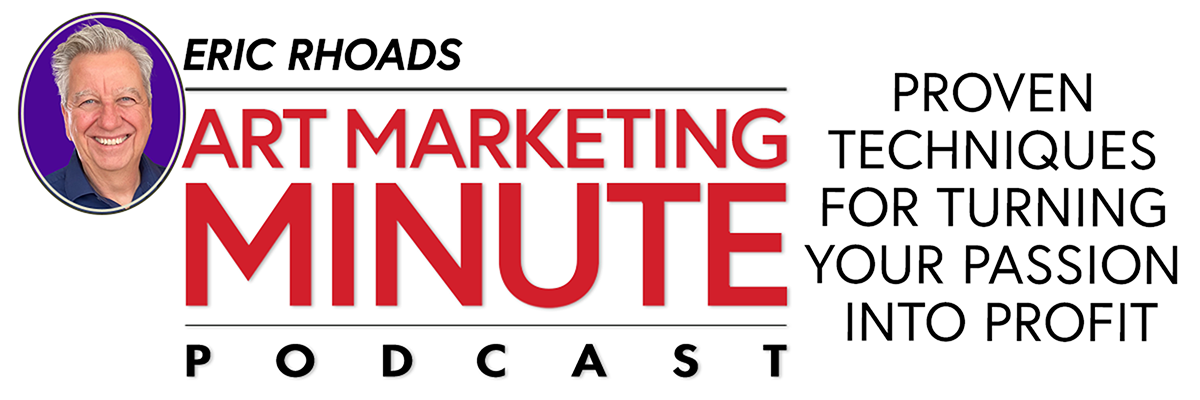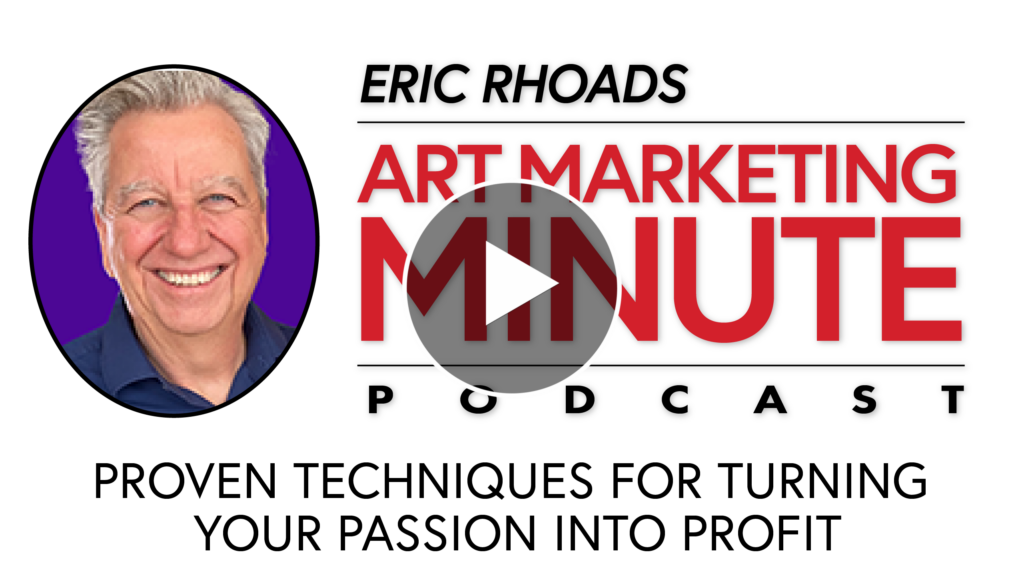In the Art Marketing Minute Podcast, you’ll learn how to sell your art, how to market your paintings, and everything else you need to know in order to have a successful art career. Each episode answers questions from artists by host Eric Rhoads, author of “Make More Money Selling Your Art,” publisher of several art magazines and newsletters, and author of ArtMarketing.com.
In this Art Marketing Minute, Eric Rhoads shares how to get your work known on a larger scale, and ideas for increasing the price of your paintings.
Listen to the Art Marketing Minute Podcast: Episode 60 >
Submit Your Art Marketing Question:
What questions do you have about selling your art? Email Eric today at [email protected] (include your name and where you’re from) to hear your question answered on an upcoming Art Marketing Minute Podcast.
FULL TRANSCRIPT of the Art Marketing Minute:
DISCLAIMER: The following is the output of a transcription from an audio recording of the Art Marketing Minute. Although the transcription is mostly correct, in some cases it is slightly inaccurate due to the recording and/or software transcription.
Announcer:
This is the Art Marketing Minute with Eric Rhoads, author of the Amazon best selling book, “Make More Money Selling Your Art.” In the marketing minute we answer your questions to help your art career brought to you by artmarketing.com, the place to go to learn more about marketing. Now, here’s your host, arts magazine publisher, Eric Rhoads.
Eric Rhoads:
In the marketing minute I answer your art marketing questions you can email yours to [email protected] and I read these sight unseen never seen them I answer them without a script because I just got to do it off the off the top of my head because that’s how I roll question from Christina Hillen in Buffalo, New York who says please keep the marketing minutes coming. They’re very inspiring. Thank you, Christina, what’s your question? My question is, I have no idea how to get my work known on a larger scale. Where do I begin? Well, I don’t know if you mean larger scale, meaning larger paintings. But assume you mean, how do you get your work known on a larger scale, I recommend that every artists have two strategies, and sometimes three, but let’s start with two. I think as an artist, you start out local. And you really get well known locally, we have a product that we created called art market in a box. It’s really designed to get people to become kind of the known artists locally in their community, and really be the person that everybody relies on for charity auctions and getting your name out there. And anytime there’s an artist mentioned in the media, it’s you and anytime that anything’s going on, it’s like – we want you to become a local star. That’s very important, because you can sell a lot locally. And there’s a lot of things you can do locally, you can’t do nationally. But the downside is that sometimes local doesn’t work. Let’s say you live in a community where, your community just isn’t, the jobs aren’t there, people aren’t making any money. And so, if you are relying entirely on one marketplace, then it’s a problem for you. That’s why we recommend also a national strategy, which means getting into some art galleries, or selling nationally in other places. Now, what I try to do is I try to put myself or I try to recommend that you go into galleries where things are really crushing it where people are making money and people are doing it, like a place like Silicon Valley, for instance. Because or, sometimes it’s a different place. Some markets get hot, for whatever reason, try to be in those markets, or maybe places that people go on vacation when they’re allowed to go on vacation. But let’s say you had a gallery in Hawaii, and everybody was going to Hawaii and now nobody’s going to Hawaii, well, you’re not going to make any money from that gallery. So that’s why you want to have two or three, I don’t recommend more than about that, some people will do more, but you’ve got to have enough quality that you can send to the galleries. And so having two or three galleries in two or three different locations around the globe, so that you’ve got a little economic stability can be a really good thing. And so I think the way to scale to get known on a larger basis, first off, get yourself a way to sell and that is through a gallery. Now you can sell direct as well. And there’s a whole nother dialogue about that. But the idea is that you’ve got to help your gallery, you can’t rely on them entirely, because it lets say I’m in a gallery with, I’ve been three galleries now. And I’m in a gallery with 30, 40, 50 other artists in some cases. And so, what’s gonna make me stand out, and the thing that’s gonna make me stand out is my name my brand, right? So you want people to seek you out. And the way to do that is you got to build a brand. So that’s when you start your advertising strategy. That’s when you start a social media strategy. Although I caution you that social media tends to be our friends, tends to be people who are not necessarily art buyers, not always, I mean, you can get them but you’ve got to have a specific strategy to get them. And then, you’ve got to work it and you’ve got to work at constantly, you got to just keep it out there year after year after year. As long as you’re in business, you’ve got to be working on your advertising and, your visibility, your publicity, things like that. So the way to begin is, start out by building your brand, getting known and getting used to selling things, maybe ramping it up locally, but then starting out nationally.
Now, here’s a question from Sean Stanley in Charleston, South Carolina. Hello, Sean. Sean says recently, my local art center had a blowout sale, you could ask $10 to $100 for your paintings. I took lots of smallish ones 11 by 14 being the largest. I’m a hobbyist I made about $300 people love some of some of them. It helped build my confidence a lot. What should my next step be? Well, there’s nothing like selling a painting to build your confidence, Sean , congratulations, I think that’s terrific. And, everybody has to start somewhere. And pricing is one of those difficult things, you know, I’m not a big low price person. But I also know that when you’re starting out, you’re not going to command a higher price until you get to the point where you’re a little bit stronger, and then you can start commanding. But I think just getting used to being able to sell paintings is a really good thing. And so do more of that. So what I recommend is you get yourself an art show at a local restaurant or something, you may or may not be strong enough to do that yet. But get some experience, set up a little sale, maybe set up a sale at your house for your friends, or an open studio, get used to selling get to the point where you’re selling. But all of us need to always work on getting better, because it’s getting better. That also builds our confidence. It’s nice to sell paintings. But it’s nice to sell paintings at higher prices, ultimately. And when you start getting, instead of $100 for painting, you start getting 200 and then 400 and then 1000 and 2000 and 5000 and then 10,000, then 100,000. That’s gonna make a big difference. Now, some of us never get there. But a lot of us do. I’m not. But I think that means that you want to be constantly pushing yourself to elevate your skills. One of the ways to do that is to enter competitions, because now you’re up against other people, and it does something in your brain, it clicks something off in your brain and makes you try harder and makes you step up and makes you say, can I make this painting better. So I think that’s a good next step, trying to art get some art competitions, and you get that validation if you win. Now, not everybody wins. And a lot of people enter many, many times and never win, and sometimes they do. And so that helps build confidence. But I think, starting out with a little local thing, I would do something at a local diner restaurant, something like that, and see if you can sell some more hundred dollar paintings. And once you get some more under your belt, maybe you can develop relationships with the people who bought those paintings and sell them some more and then gradually ratchet up your prices 250 to 200 and 300 and so on. And, if you’re a hobbyist and you only want to be a hobbyist that’s cool, too. There’s nothing wrong with that. So congratulations. I applaud you on that.
Well, this has been the art marketing minute with me. Eric Rhoads. My goal in life is to eliminate the idea of the starving artist to help your dreams actually come true. So if you want to submit questions, simply email [email protected]. And to learn more about marketing ideas, you can visit Artmarketing.com. Thanks for listening.
How to Submit Your Art Marketing Questions: What questions do you have about selling your art? Email Eric today at [email protected] (include your name and where you’re from) to hear your question answered on an upcoming Art Marketing Minute Podcast.



Leave A Comment